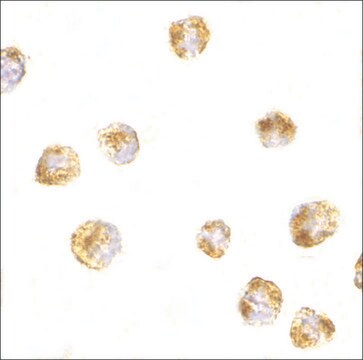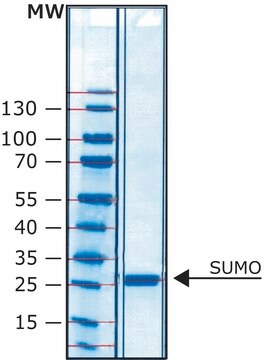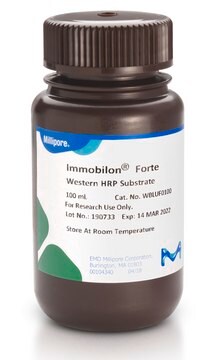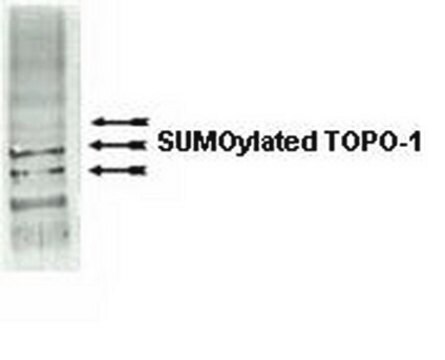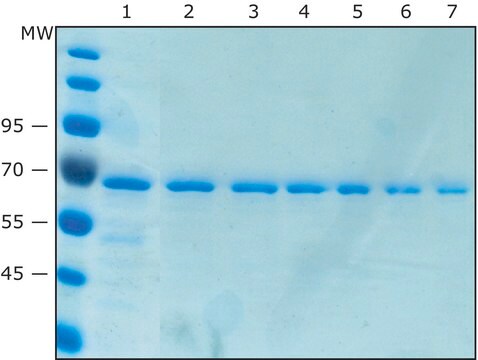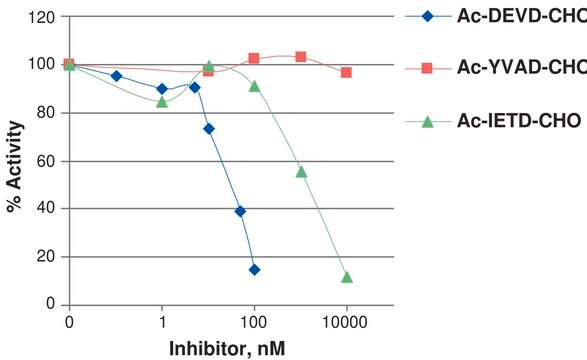おすすめの製品
由来生物
mouse
品質水準
抗体製品の状態
purified immunoglobulin
抗体製品タイプ
primary antibodies
クローン
8A2, monoclonal
交差性
human
包装
antibody small pack of 25 μg
テクニック
immunocytochemistry: suitable
immunoprecipitation (IP): suitable
western blot: suitable
アイソタイプ
IgG2bκ
NCBIアクセッション番号
輸送温度
ambient
ターゲットの翻訳後修飾
unmodified
遺伝子情報
human ... SUMO2(6613)
詳細
Small ubiquitin-related modifier 2 (UniProt P61956; also known as HSMT3, Sentrin-2, SMT3 homolog 2, Smt3B, SUMO-2, Ubiquitin-like protein SMT3B) and 3 (UniProt P55854; also known as SMT3 homolog 1, Smt3A, SUMO-3, Ubiquitin-like protein SMT3A) are encoded by the SUMO2 (also known as SMT3B, SMT3H2; Gene ID 6613) and SUMO3 (also known as SMT3A, SMT3H1; Gene ID 6612) genes in human. SUMOylation, protein post-translation modification by small ubiquitin-like modifier (SUMO), is a signaling event in many cellular processes. SUMO proteins are translated as immature precursors and subsequently converted to their mature forms through the activity of sentrin/SUMO-specific proteases (SENPs). SUMOylation is a reversible process. SUMO E1 activating enzyme, E2 conjugating enzyme, and E3 ligase mediate SUMOylation of substrate proteins, while SENPs are responsible for the de-SUMOylation. SUMOylation usually occurs at lysine residues in the consensus KxD/E motif, although not all such lysines become SUMOylated and SUMOylation can also occur on lysine residues outside of this motif. SUMO2 and 3 share 97% identity at the amino acid level, while SUMO1 shares only about 50% sequence homology with SUMO-2 and 3. In addition to difference in their target substrates, SUMO2/3 can be SUMOylated and form chains, whereas SUMO1 cannot and may serve as chain terminator. SUMO-2 can be covalently attached to proteins as a monomer or as a lysine-linked polymer. Its covalent attachment to its substrate via an isopeptide bond requires prior activation by the E1 complex SAE1-SAE2 and linkage to the E2 enzyme UBE2I, and can be promoted by an E3 ligase such as PIAS1-4, RANBP2, CBX4 or ZNF451. This post-translational modification on lysine residues of proteins plays a crucial role in a number of cellular processes such as nuclear transport, DNA replication and repair, mitosis and signal transduction. Although SUMO-2 functions in a manner similar to ubiquitin in that it is bound to target proteins as part of a post-translational modification system, however, unlike ubiquitin which targets proteins for degradation, SUMO-2 is involved in a variety of cellular processes, such as nuclear transport, transcriptional regulation, apoptosis, and protein stability. It is not active until the last two amino acids of the carboxy-terminus (aa 94-95; propeptide) have been cleaved off.
特異性
Clone 8A2 detects SUMO-2/3 in human cells.
免疫原
GST-tagged full length recombinant human SUMO-2 protein.
アプリケーション
Research Category
細胞シグナル伝達
細胞シグナル伝達
Anti-SUMO-2/3, clone 8A2, Cat. No. MABS2039, is a mouse monoclonal antibody that detects SUMO-2 and SUMO-3 and has been tested for use in Immunocytochemistry, Immunoprecipitation, and Western Blotting.
Western Blotting Analysis: A representative lot detected SUMO-2/3 in Western Blotting applications (Zhang, X.D., et. al. (2008). Mol Cell. 29(6):729-41; Zhu, S., et. al. (2009). Mol Cell. 33(5):570-80).
Immunoprecipitation Analysis: A representative lot detected SUMO-2/3 in Immunoprecipitation applications (Zhu, S., et. al. (2009). Mol Cell. 33(5):570-80).
Western Blotting Analysis: A 1:500 dilution from a representative lot detected SUMO-2/3 in HeLa cell lysate (Courtesy of Christine Lee, Matunis Lab, John Hopkins University, Baltimore, Maryland USA).
Immunocytochemistry Analysis: A 1:500 dilution from a representative lot detected SUMO-2/3 in HeLa cells (Courtesy of Christine Lee, Matunis Lab, John Hopkins University, Baltimore, Maryland USA).
Immunocytochemistry Analysis: A representative lot detected SUMO-2/3 in Immunocytochemistry applications (Zhang, X.D., et. al. (2008). Mol Cell. 29(6):729-41; Rao, H.B., et. al. (2017) Science. 355(6323):403-407).
Immunocytochemistry Analysis: A 1:500 dilution from a representative lot detected SUMO-2/3 in HeLa cells.
Immunoprecipitation Analysis: A representative lot detected SUMO-2/3 in Immunoprecipitation applications (Zhu, S., et. al. (2009). Mol Cell. 33(5):570-80).
Western Blotting Analysis: A 1:500 dilution from a representative lot detected SUMO-2/3 in HeLa cell lysate (Courtesy of Christine Lee, Matunis Lab, John Hopkins University, Baltimore, Maryland USA).
Immunocytochemistry Analysis: A 1:500 dilution from a representative lot detected SUMO-2/3 in HeLa cells (Courtesy of Christine Lee, Matunis Lab, John Hopkins University, Baltimore, Maryland USA).
Immunocytochemistry Analysis: A representative lot detected SUMO-2/3 in Immunocytochemistry applications (Zhang, X.D., et. al. (2008). Mol Cell. 29(6):729-41; Rao, H.B., et. al. (2017) Science. 355(6323):403-407).
Immunocytochemistry Analysis: A 1:500 dilution from a representative lot detected SUMO-2/3 in HeLa cells.
品質
Evaluated by Western Blotting in HeLa cell lysate.
Western Blotting Analysis: 4 µg/mL of this antibody detected SUMO-2/3 in HeLa cell lysate.
Western Blotting Analysis: 4 µg/mL of this antibody detected SUMO-2/3 in HeLa cell lysate.
ターゲットの説明
~19 kDa observed; 10.87 kDa calculated. Uncharacterized bands may be observed in some lysate(s).
物理的形状
Protein G purified
Format: Purified
Purified mouse monoclonal antibody IgG2b in buffer containing 0.1 M Tris-Glycine (pH 7.4), 150 mM NaCl with 0.05% sodium azide.
保管および安定性
Stable for 1 year at 2-8°C from date of receipt.
その他情報
Concentration: Please refer to lot specific datasheet.
免責事項
Unless otherwise stated in our catalog or other company documentation accompanying the product(s), our products are intended for research use only and are not to be used for any other purpose, which includes but is not limited to, unauthorized commercial uses, in vitro diagnostic uses, ex vivo or in vivo therapeutic uses or any type of consumption or application to humans or animals.
適切な製品が見つかりませんか。
製品選択ツール.をお試しください
保管分類コード
12 - Non Combustible Liquids
WGK
WGK 1
引火点(°F)
does not flash
引火点(℃)
does not flash
適用法令
試験研究用途を考慮した関連法令を主に挙げております。化学物質以外については、一部の情報のみ提供しています。 製品を安全かつ合法的に使用することは、使用者の義務です。最新情報により修正される場合があります。WEBの反映には時間を要することがあるため、適宜SDSをご参照ください。
Jan Code
MABS2039-25UG:
MABS2039:
試験成績書(COA)
製品のロット番号・バッチ番号を入力して、試験成績書(COA) を検索できます。ロット番号・バッチ番号は、製品ラベルに「Lot」または「Batch」に続いて記載されています。
ライフサイエンス、有機合成、材料科学、クロマトグラフィー、分析など、あらゆる分野の研究に経験のあるメンバーがおります。.
製品に関するお問い合わせはこちら(テクニカルサービス)